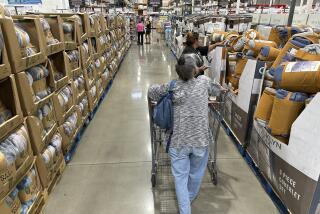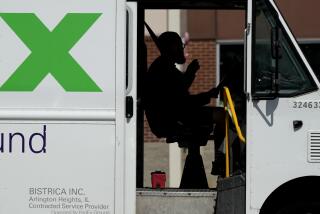GDP rebounded by record 33% annual rate last quarter, but resurgent pandemic threatens recovery

The U.S. economy grew at a record-setting pace in the third quarter, but it wasn’t nearly enough to make up for the unprecedented devastation caused by COVID-19 or to allay fears of new damage from a resurgent pandemic.
The Commerce Department said Thursday that third-quarter gross domestic product — the broadest measure of economic activity — rose at a 33.1% annual rate, after adjusting for inflation. That was by far the fastest quarter-over-quarter jump on record and was driven by a strong rebound in spending by both consumers and businesses, much of it during the early summer when local lockdown restrictions were eased in expectation of a subsiding pandemic.
In addition, personal income and consumption were boosted during the quarter by massive federal aid in the form of $1,200 checks to millions of Americans, higher jobless insurance payments and other measures.
Now, with the emergency aid programs mostly expired and little likelihood of new help anytime soon, the economic outlook is much darker.
The latest GDP report “underscores the resilience embedded with the American economy,” said Joseph Brusuelas, chief economist at the accounting firm RSM US. “Yet [it] massively overstates the nature of the rebound and the true condition of the U.S. economy, which remains significantly impaired.”
A separate report Thursday from the Labor Department showed 751,000 people applied for first-time unemployment benefits last week, down 40,000 from the prior week.
But the most recent figure is still more than three times the average in the weeks prior to the coronavirus outbreak and lockdowns in March, reflecting continued large-scale layoffs and distress in the labor market.
California’s share of new jobless claims remains disproportionately large, accounting for 1 in 5 in the nation last week.
“The economic recession is officially over, but many are not thriving, they are just barely surviving,” said Christopher Rupkey, managing director and chief financial economist at MUFG Bank in New York. “GDP growth is up today, but with a new surge in coronavirus cases nationwide to the highest new cases seen to date, one has to ask how long will this economic recovery be able to stay on track and put the millions of jobless Americans back to work.”
Thursday’s GDP estimate was the last major economic report before Tuesday’s election. And President Trump’s campaign immediately hailed the news as “absolute validation” of Trump’s policies and management of the economy.
“The president built the world’s best economy and he’s rapidly doing it again,” his campaign spokesman, Tim Murtaugh, said in a statement.
But Trump’s record on the economy isn’t as strong as he has claimed, and the latest surge in COVID-19 infections has raised the specter of another downturn, sparking a sell-off on Wall Street in recent days and renewing calls from business groups and worker advocates for additional fiscal relief.
On Thursday, the Dow Jones industrial average snapped a four-day losing streak, eking out a half-percent gain, or 139 points, to close at 26,659 after plunging 943 points a day earlier.
Trump’s Democratic challenger, former Vice President Joe Biden, in a statement, said, “We are in a deep hole,” blaming Trump for a recovery that was fading and that had helped those at the top while not doing enough for many working families and small businesses.
“It’s clear that the small business community, nearly half of the GDP, need additional financial assistance to keep their doors open,” said Holly Wade, executive director of research at the National Federation of Independent Business.
In a new survey released Thursday, the small-employer lobbying group said 90% of its members who borrowed money from the federal government’s forgivable loan program had used up all the funds. And 1 in 5 of them said they anticipated laying off employees in the next six months.
“We’re still struggling like crazy,” said Michelle Barron, who started the Book House, a book retailer in the St. Louis area, in 1986. She borrowed $11,000 from the federal loan program and got a $12,000 grant from St. Louis County but is two months behind in rent. The upcoming holiday season will make or break her business, she said.
“I have no idea what we’re going to do in November and December,” said the 56-year-old. “It’s either let people in and risk our health and the health of everybody coming in here, or go out of business.”
What happens the rest of the year will depend on the pandemic. With infections rising, many people remain wary of going out, and tougher restrictions could be imposed. At this point, most experts expect the economy to keep growing, albeit at a much slower pace.
“The momentum heading into the fourth quarter is quite weak,” said Ben Herzon, executive director of U.S. economics at IHS Markit, a forecasting firm. He noted that economic output in the last couple of months had “slowed to a crawl.”
The big rebound in the third quarter was fueled by a huge 40.7% annual rate of increase in consumer spending, which accounts for the bulk of U.S. economic activity.
Car sales were particularly strong, as were clothes and shoes. On services, healthcare led the way. Spending for food services and hotels also rose.
“This is a remarkable rebound considering that unemployment remains high, at 7.9% in September, compared with 3.5% at the start of the year,” said Cailin Birch, global economist at the Economist Intelligence Unit.
“However, we do not expect this consumer resilience to continue in the fourth quarter,” she said. “The supplementary federal benefits that helped to cushion household incomes during the depth of the crisis expired in July, and Congress will struggle to pass a second stimulus bill before the end of the year. As a result, millions of households are likely to be in a more precarious financial position in the fourth quarter than they were even at the depth of the crisis.”
Spending by businesses in the third quarter surged as well. Companies bought equipment after putting off new investments in the spring, and there was a burst of activity in the housing market, propelled by record-low interest rates.
On the whole, the third-quarter rebound recouped only about two-thirds of what the economy lost in the first half of the year.
GDP fell by a 5% annual rate in the first quarter and by 31.4% in the second. In the prior three years, GDP expanded on average by 2.6% a year, a solid pace close to the economy’s potential.
Many economic experts, including Federal Reserve policymakers, are projecting real GDP for this year to fall about 4%, which would be the steepest decline since World War II.
A complete recovery in the labor market is likely to take even longer. The economy lost about 22 million jobs in early spring and has since recovered about half them.
Job growth, however, has been slowing. And economists don’t see the country returning to full employment, essentially where it was before the pandemic, until 2024.
More to Read
Get the L.A. Times Politics newsletter
Deeply reported insights into legislation, politics and policy from Sacramento, Washington and beyond. In your inbox three times per week.
You may occasionally receive promotional content from the Los Angeles Times.







